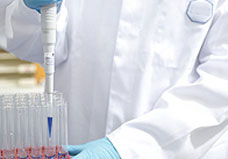| |
 |
|
|
|
|
|
|
Hypospadias |
|
|
What is hypospadias?
Hypospadias is a malformation that affects the urethral tube and
the foreskin on a male's penis. The urethra is the tube that
carries urine from the bladder to the outside of the body.
Hypospadias is a disorder in which the male urethral opening is
not located at the tip of the penis. The urethral opening can be
located anywhere along the urethra. Most commonly with hypospadias,
the opening is located along the underside of the penis, near the
tip.
What causes hypospadias?
Hypospadias is a congenital (present at birth) anomaly
(abnormality), which means that the malformation occurs during
fetal development. As the fetus develops, the urethra does not
grow to its complete length. Also during fetal development the
foreskin does not develop completely, which typically leaves extra
foreskin on the topside of the penis and no foreskin on the
underside of the penis.
Who is affected by hypospadias?
-
Hypospadias is a disorder that
primarily affects male newborns
-
It occurs in about one in
every 150 to 300 boys.
-
Hypospadias also has a genetic
component. Some studies have shown fathers of males with
hypospadias to also have had the condition. Other studies have
shown fathers of males with hypospadias also had the condition.
-
Some newborn boys who have
other congenital abnormalities such as undescended testes or
inguinal hernias may also have hypospadias.
What
are the symptoms of hypospadias?
The following are the most common symptoms of hypospadias.
However, each child may experience symptoms differently. Symptoms
may include:
-
abnormal appearance of
foreskin and penis on exam
-
abnormal direction of urine
stream
-
the end of the penis may be
curved downward
The symptoms of a hypospadias
may resemble other conditions or medical problems. Always consult
your child's physician for a diagnosis.
Treatment for hypospadias:
Specific treatment for hypospadias will be determined
by your child's physician based on:
-
your child's age, overall
health, and medical history
-
the extent of the disease
-
your child's tolerance for
specific medications, procedures, or therapies
-
expectations for the
course of the disease
-
your opinion or preference
Hypospadias can be repaired with
surgery. Usually, the surgical repair is done when your child is
between 6 and 12 months, when penile growth is minimal. At birth,
your male child will not be able to undergo circumcision, as the
extra foreskin may be needed for the surgical repair. The surgical
repair can usually be done on an outpatient basis.
If a hypospadias deformity is not repaired, the following
complications may occur as your child grows and matures:
-
Your child's urine stream may
be abnormal. The stream may point in the direction of the
opening, or it may spread out and spray in multiple directions.
-
The penis may curve as your
child grows causing sexual dysfunction later in life.
-
If the urethral opening is
closer to the scrotum or perineum, your child may have problems
with fertility later in life.
|
|
|
|
Hypospadias - treatment of Hypospadias,
Hypospadias types, Disease medicines, Hypospadias symptoms, Hypospadias and
Disease symptoms, Hypospadias symptoms Disease and diagnosis, Symptoms and
Solutions, Signs and Symptoms, type of Hypospadias, cause common, common
Hypospadias, Hypospadias List, causes list, Infectious Hypospadias, Causes,
Diseases , Types, Prevention, Treatment and Facts, Hypospadias information,
Hypospadias: Definition, Hypospadias names, medical Hypospadias, medical
Hypospadias and disorders, cell Hypospadias, Hypospadias Worldwide,
Hypospadias Research, Hypospadias Control, Hypospadias Center, Digestive
Hypospadias Week, Information about Hypospadias, causes of different
Hypospadias, Hypospadias Articles, Hypospadias and conditions, Health and
Hypospadias, Hypospadias Patients, Hypospadias and Sciences, causes of
alzheimer's Hypospadias, Hypospadias causes, alternative medicine heart
Hypospadias, body ailments, Hypospadias medicines, medical antiques, type of
blood Hypospadias |
|
|





